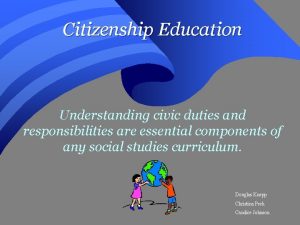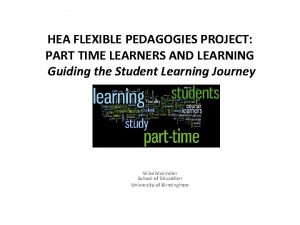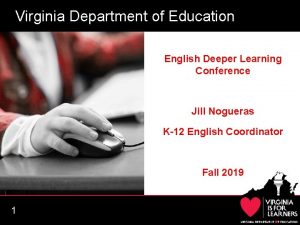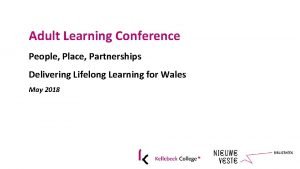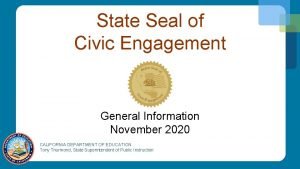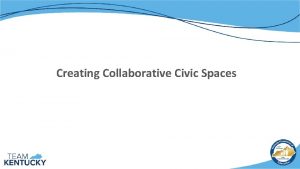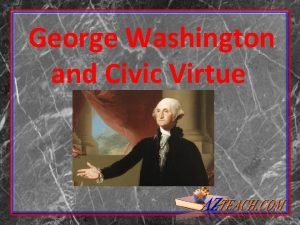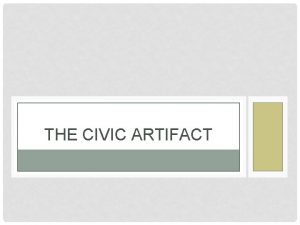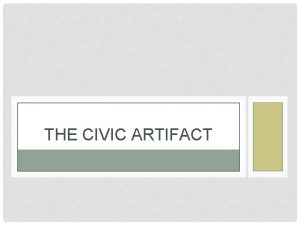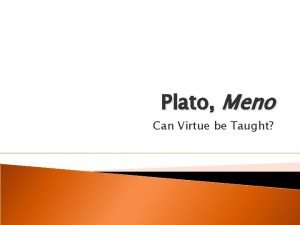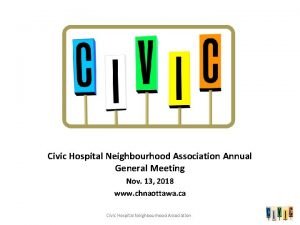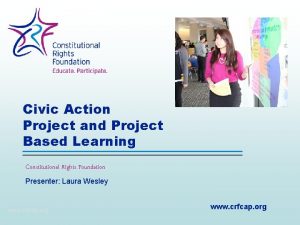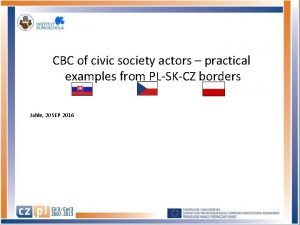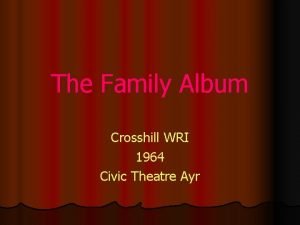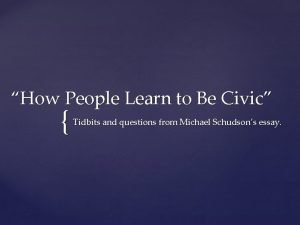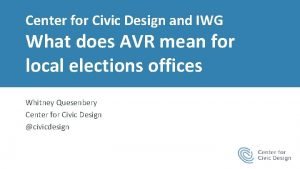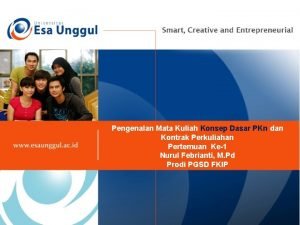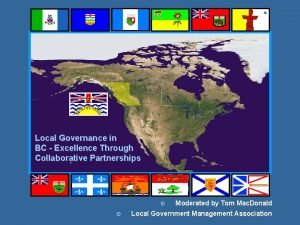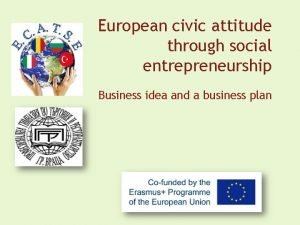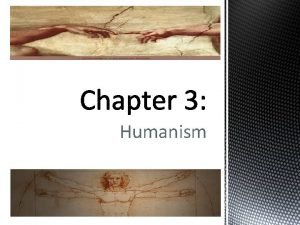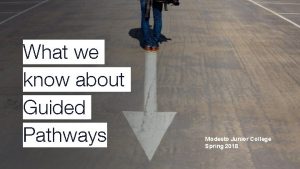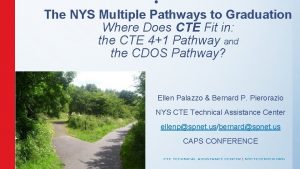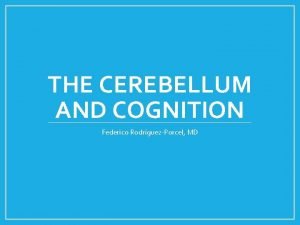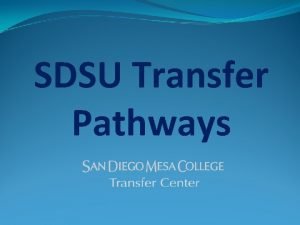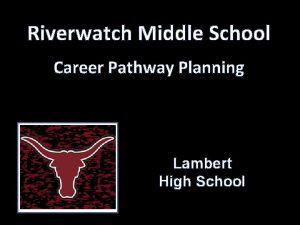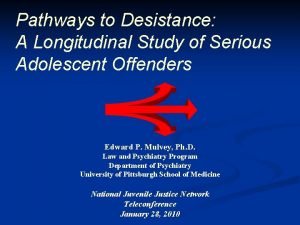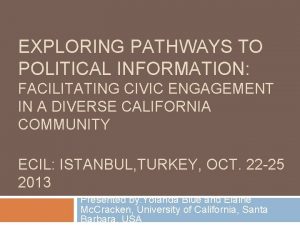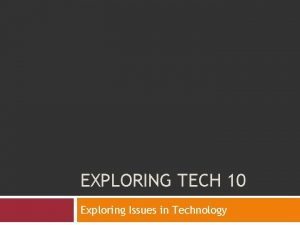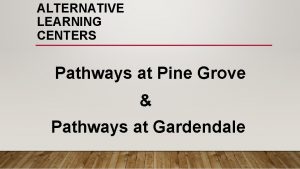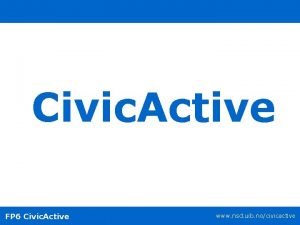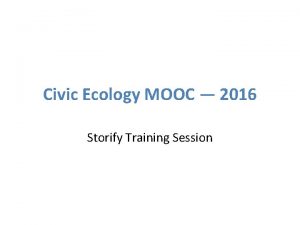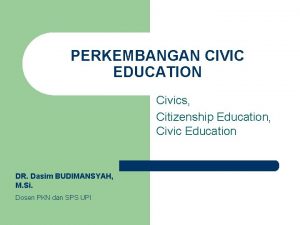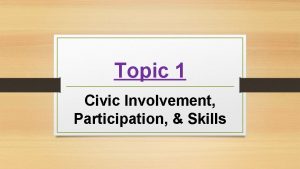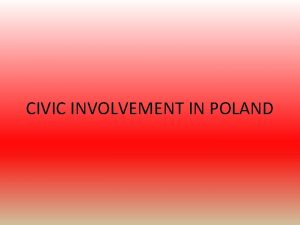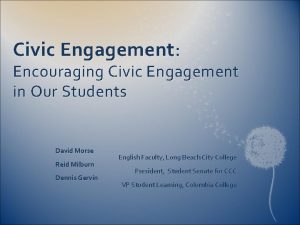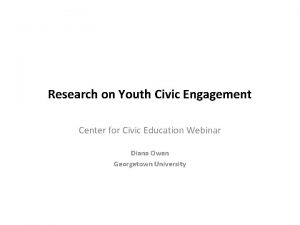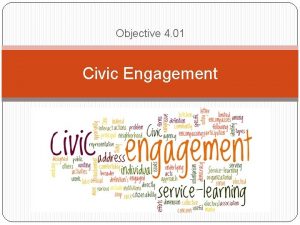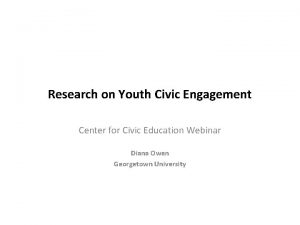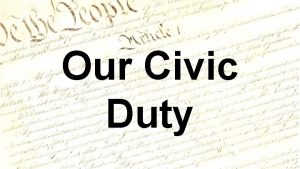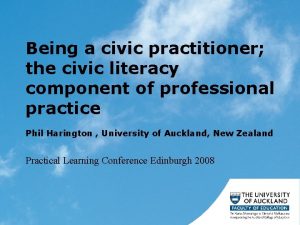Pathways to Civic Learning Conference Exploring how civic





































- Slides: 37

Pathways to Civic Learning Conference: Exploring how civic engagement can increase college retention and success, while closing achievement gaps Joanna Gonsalves, Salem State University Eric Metchik, Salem State University Cate Kaluzny, North Shore Community College Mark Wagner, Worcester State University (with contributions from the Greater Boston Service. Learning Research Consortium)

Central Aim: To research how civic engagement (both curricular and co-curricula) can, not only prepare students for civic life and democratic leadership, but also improve learning and college success for students from all backgrounds.

Study Consortium Highlights Re-frame our thinking about the purpose of civic learning in higher education, based on national and local conversations. Draw from empirical research about which sorts of civic learning and engagement activities are most impactful (and for whom). Identify and share exemplars of signature civic enterprises on our campuses Encourage conversations about how to intentionally infuse civic learning and engagement more pervasively

SOURCES AND THREADS I. FROM CIVIC PROMPTS (C. M. MUSIL, AAC&U, 2015) a) To what extent should civic learning/engagement be “enforced” on our campuses (from both faculty and student perspectives), in the name of making them pervasive across the disciplines?

b) Be careful about the language used as part of efforts to make civic learning/engagement relevant across many disciplines. Ex: “disciplinary issues” might be clearer than “civic activities” for non-political scientists…

II. From Service-Learning at the American Community College (A. Traver and Z. Katz, Eds. , 2014) The tension between vocational preparation and civic missions of higher education

Can activities such as service-learning bridge this divide, while addressing other core philosophical questions relating to identity, humanity and charity? How to integrate these broader questions into active experiential learning?

III. From To Serve a Larger Purpose(J. Saltmarsh and M. Hartley, Eds. , 2011) a) The distinction between civic “activity” and civic “experience” b) The “democratization” of civic engagement – how to nurture this across all disciplines, including STEM?

IV. From A Crucible Moment (AAC & U, 2012) Research clearly documents the relationship between various forms of civic engagement (such as servicelearning) and academic retention and success, yet efforts so far have been haphazard, peripheral, optional. Not yet integrated as part of most colleges’ core mission.

We need to go beyond a one-course civics requirement and instead focus on an infusion of civic learning outcomes at all educational levels for students from all racial/ethnic constituencies. Reward faculty for incorporating civic engagement in their classes, especially in terms of tenure/promotion

A Closer Look at Research Findings

Factors investigated in our consortium research (2012 -2015)

Study Methodology Pretest and post-test surveys administered within service-learning courses and traditional courses.

Study Sample n = 117 service learning students and 27 matched controls Salem State University 72% Female Bunker Hill Community College 55% Age 18 -25 Middlesex Community College 37% Self identify as non-white North Shore Community College 56% Full-time student Northern Essex Community College 39% First generation college students Roxbury Community College 56% Family Household Income below $30, 000 61% Desire Bachelors degree or higher

Texting Sub-study (n = 19) Conducted pilot study to capture students’ immediate reactions to their community experiences. Ratings were made about placement characteristics. Statements were relayed about the most significant interaction during their day’s service.

Survey Outcomes Global Self- Efficacy increased for the group (p. <. 01); The increase for the control group was not significant. Learner Empowerment went down slightly on all subscales for the group as a whole, but the change was not statistically significant 16

What really matters: Characteristics of the learning experience Skill Variety Task Identity Autonomy /Agency Feedback & Support Personal Significance Change in global SELF EFFICACY r . 348** . 300* . 352** . 354** . 409** p . 000 . 002 . 000 . 05 . 000 Change in Learner IMPACT r . 290** . 388 . 407** . 467** . 286** p . 002 . 000 . 003 Change in Learner MOTIVATION r . 217* . 338** . 315** . 438** . 301** p . 024 . 000 . 001 Change in Learner CONFIDENCE r . 213* . 185 . 206* . 259** . 244** p . 026 . 054 . 032 . 007 . 011 * Correlation is significant at the 0. 05 level (2 -tailed). ** Correlation is significant at the 0. 01 level (2 -tailed). 17

Findings related to Student Demographics Greater change in Learner Impact for traditionally aged students (18 -25) than older students (p =. 035). Greater change in Efficacy for students who have been in college less than 2 years compared to students in college over 2 years (. 05) Change in Efficacy for first generation college students was slightly higher (+1. 41 points) than nonfirst gen (+1. 05 points) Change in Efficacy for students of color was greater (+. 278 points) than for white students (. 008 points). 18

Implications and Next Steps: Build on findings with consortium institutions to emphasize two specific foci: § The impact of whole-class civic learning projects (with and without engagement) where students, faculty, other campus and community members work together to address common problems and strengthen communities § Recognize that a one-size-fits all approach will not work – given varying student needs, community needs, curricula goals and faculty foci.

Whole Campus Participation: Civic Learning across the Disciplines

Making Civic Learning and Democratic Engagement “Unavoidable” for Our Students Expand the too narrow view of what it is. Define what is a “Civic-Minded” Institution Students need multiple opportunities to develop the skills needed to function as interdependent actors in a diverse society. A Crucible Moment: College Learning and Democracy’s Future

A Framework for Twenty-First Century Civic Learning and Democratic Engagement Knowledge Skills Values Collective Action

What would a Civic Minded Campus Look Like Civic Ethos governing campus Life Civic Literacy as a goal for every student Civic Inquiry integrated within the majors and general education Civic Action as lifelong practice

From Partial to Pervasive Civic Learning is Optional Civic Learning is expected for All Civic Learning is a 1 time Experience Civic Learning is Infused Mission and Vision Statements do not explicitly address civic responsibility Mission and Vision statements explicitly address civic responsibility.

College Writing I Students made improvements on a trail in Lynn Woods Reservation to make it accessible for wheel chairs.

Composition I

Advanced Cosmetology

College Reading I

Exploring Sustainability

Biology I

American Cuisine

Drawing I Students Created a Series of Easels depicting the Six Pillars of Character to be placed in a local school entry way.

Building Partnerships

How do we attain civic renewal? “. . . The potential for civic renewal is in the entire institution, not in any single unit or particular program. The power of these institutions is in the totality of their resources. . . There is a need to infuse the civic into all curricular and co-curricular activities and into all disciplines and fields. If only a few of these institutions were to think of themselves in this way, the outcomes would be extraordinary. ” Civic Engagement, Civic Learning, and Higher Education, Barry Checkoway. Civic Provocations

Community Leadership Experience at WSU (CLEWS) Materials and Methods • Early Move in • First Year Seminar • CLEWS Conversations • Make a Difference Day, Alternative Spring Break, Earth Day • Advising as to Campus Leadership Roles such as RA, Peer Mentors, Orientation Leaders, and Student Government Engaging the Middle Tier: In 2011, Mark Wagner (BCCE) and Adrian Gage (Res Life) designed a program called the Community leadership Experience at WSU (CLEWS) that aimed to study a cohort from our middle tier students (2. 6 – 3. 2). Based in part on Care Theory (Nel Noddings), each year, we invite 20 students to participate in program designed around leadership and community engagement as a way to retain this group. We were, in part, using Care Theory as theoretical backdrop, and our practice would include First Year Seminar and Beyond the Traditional Classroom projects to build social bonds and ties to both the campus and wider community.

OG CLEWS: June ‘ 16 Mark Wagner and Adrian Gage OG CLEWS: OG Control: Retained: 85% Graduated Early: 3 (15%) 4 Year Graduation Rate: 65% 41/2 Graduation Rate (anticipated) 75% Dean’s List: 9 Ave. GPA: 2. 8 Leadership Roles: 8 (40%) Judicial Findings: 8 Retained: 70% Graduated Early: 0 4 Year Graduation Rate: 7 (35%) Dean’s List: 12 Ave. GPA: 3. 2 S. floridanus Leadership NA and. Roles: S. Judicial Findings: 9 transitional is skull morphologic al differences. Ra bbit fecal pellets. Tra B cks of an unidentified rabbit.

Student Affairs -Involvement and Leadership Residence Life and Housing CLEWS WSU Foundation + Admin = $ Academic Affairs = FYS / Academic Success
 Civic citizenship
Civic citizenship Difference between duties and responsibilities
Difference between duties and responsibilities Flexible learning pathways
Flexible learning pathways Cuadro comparativo e-learning y b-learning
Cuadro comparativo e-learning y b-learning Deeper learning conference
Deeper learning conference Lifelong learning conference 2018
Lifelong learning conference 2018 The civic mirror
The civic mirror California seal of civic engagement
California seal of civic engagement Civic space collaborative
Civic space collaborative Civic engagement meaning
Civic engagement meaning Civic mirror hidden agenda
Civic mirror hidden agenda How did washington show civic virtue
How did washington show civic virtue Brampton civic hospital pharmacy
Brampton civic hospital pharmacy What is a civic artifact
What is a civic artifact Examples of civic artifacts
Examples of civic artifacts Whats the definition of virtue
Whats the definition of virtue Web design civic
Web design civic Civic hospital neighbourhood association
Civic hospital neighbourhood association Tumbler
Tumbler Civic actors examples
Civic actors examples Audrey howatt
Audrey howatt Civic event definition
Civic event definition Be civic
Be civic Tessa sutton
Tessa sutton Center for civic design
Center for civic design Apa itu civic education
Apa itu civic education Civic infobc
Civic infobc Civic attitude
Civic attitude Civic humanism meaning
Civic humanism meaning Civic infotech
Civic infotech Chemical feed station
Chemical feed station Pathways modesto
Pathways modesto Nycte
Nycte Spinocerebellar
Spinocerebellar South forsyth high school pathways
South forsyth high school pathways Sdsu transfer pathways
Sdsu transfer pathways Lambert high school pathways
Lambert high school pathways Pathways to desistance
Pathways to desistance
